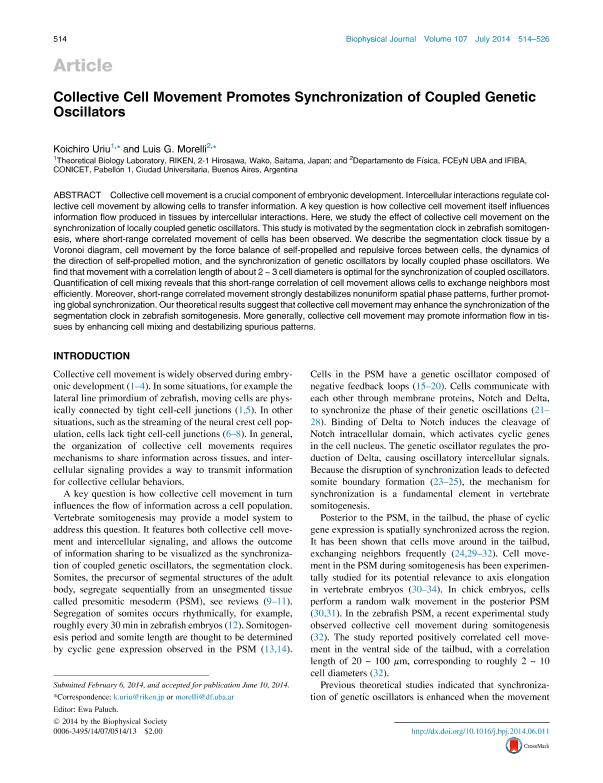Mostrar el registro sencillo del ítem
dc.contributor.author
Koichiro, Uriu
dc.contributor.author
Morelli, Luis Guillermo

dc.date.available
2017-06-09T21:27:27Z
dc.date.issued
2014-07
dc.identifier.citation
Koichiro, Uriu; Morelli, Luis Guillermo; Collective cell movement promotes synchronization of coupled genetic oscillators; Cell Press; Biophysical Journal; 107; 2; 7-2014; 514-526
dc.identifier.issn
0006-3495
dc.identifier.uri
http://hdl.handle.net/11336/17950
dc.description.abstract
Collective cell movement is a crucial component of embryonic development. Intercellular interactions regulate collective cell movement by allowing cells to transfer information. A key question is how collective cell movement itself influences information flow produced in tissues by intercellular interactions. Here, we study the effect of collective cell movement on the synchronization of locally coupled genetic oscillators. This study is motivated by the segmentation clock in zebrafish somitogenesis, where short-range correlated movement of cells has been observed. We describe the segmentation clock tissue by a Voronoi diagram, cell movement by the force balance of self-propelled and repulsive forces between cells, the dynamics of the direction of self-propelled motion, and the synchronization of genetic oscillators by locally coupled phase oscillators. We find that movement with a correlation length of about 2 ~ 3 cell diameters is optimal for the synchronization of coupled oscillators. Quantification of cell mixing reveals that this short-range correlation of cell movement allows cells to exchange neighbors most efficiently. Moreover, short-range correlated movement strongly destabilizes nonuniform spatial phase patterns, further promoting global synchronization. Our theoretical results suggest that collective cell movement may enhance the synchronization of the segmentation clock in zebrafish somitogenesis. More generally, collective cell movement may promote information flow in tissues by enhancing cell mixing and destabilizing spurious patterns.
dc.format
application/pdf
dc.language.iso
eng
dc.publisher
Cell Press

dc.rights
info:eu-repo/semantics/openAccess
dc.rights.uri
https://creativecommons.org/licenses/by-nc-sa/2.5/ar/
dc.subject
Genetic Oscillators
dc.subject
Synchronization
dc.subject
Cell Motility
dc.subject.classification
Otras Ciencias Físicas

dc.subject.classification
Ciencias Físicas

dc.subject.classification
CIENCIAS NATURALES Y EXACTAS

dc.subject.classification
Biología del Desarrollo

dc.subject.classification
Ciencias Biológicas

dc.subject.classification
CIENCIAS NATURALES Y EXACTAS

dc.title
Collective cell movement promotes synchronization of coupled genetic oscillators
dc.type
info:eu-repo/semantics/article
dc.type
info:ar-repo/semantics/artículo
dc.type
info:eu-repo/semantics/publishedVersion
dc.date.updated
2017-06-09T14:15:48Z
dc.journal.volume
107
dc.journal.number
2
dc.journal.pagination
514-526
dc.journal.pais
Estados Unidos

dc.description.fil
Fil: Koichiro, Uriu. Riken; Japón
dc.description.fil
Fil: Morelli, Luis Guillermo. Consejo Nacional de Investigaciones Científicas y Técnicas. Oficina de Coordinación Administrativa Ciudad Universitaria. Instituto de Física de Buenos Aires. Universidad de Buenos Aires. Facultad de Ciencias Exactas y Naturales. Instituto de Física de Buenos Aires; Argentina
dc.journal.title
Biophysical Journal

dc.relation.alternativeid
info:eu-repo/semantics/altIdentifier/doi/http://dx.doi.org/10.1016/j.bpj.2014.06.011
dc.relation.alternativeid
info:eu-repo/semantics/altIdentifier/url/http://www.sciencedirect.com/science/article/pii/S0006349514006171?via%3Dihub
Archivos asociados
